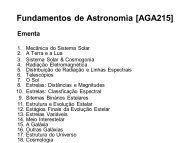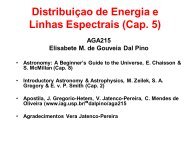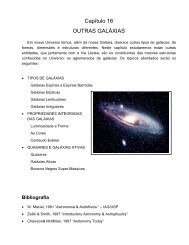A multi-state HLL approximate Riemann solver for ideal ...
A multi-state HLL approximate Riemann solver for ideal ...
A multi-state HLL approximate Riemann solver for ideal ...
You also want an ePaper? Increase the reach of your titles
YUMPU automatically turns print PDFs into web optimized ePapers that Google loves.
T. Miyoshi, K. Kusano / Journal of Computational Physics 208 (2005) 315–344 331u g e 1 1R2 q R jv R j2 2 jB R j2¼ q Rn2 f2 þ p R f þ p Rnc 1 þ q Rn2 ðjv ? Rj 2 jv ? Rj 2 Þþ n 2 ðjB ? Rj 2 jB ? Rj 2 Þþ f 2 ðjB ? Rj 2 þjB ? Rj 2 Þþ B x ðv ?R B ?R v ? R B ? RÞ¼ q Rn21jB ?R j 2q R ng B 2 x!f 2 þ p R f þ p Rnc 1 ; ð94Þwhere v^ = (0, v, w) and B^ = (0, B y , B z ). It is noted that (94) is identical to the corresponding equation <strong>for</strong>the <strong>HLL</strong>C <strong>solver</strong> [2] except <strong>for</strong> the correction in the first term. Since S R is expressed by k 7 of (3) and is themaximum speed in the <strong>Riemann</strong> system, the inequalities, n P c fR and g P c fR , will be satisfied. There<strong>for</strong>e,!u 0 ¼ q Rn jB ?R j 21f 2 þ p2 q R c 2 f RB 2 R f þ p Rn6 u: ð95Þc 1xThis relation indicates that u is necessarily positive if u 0 is positive. (We point out here that Gurski [13]misled a ‘‘stronger condition’’ <strong>for</strong> positivity in view of the inequality (95).) Sinceqc 2 fjBj 2 ¼ qc 2 fB 2 xjB ? j 2 > 0 except when B^ = 0 and B 2 xP cp, the first term of (95) is necessarily positive.Note that u in the case of B^ = 0 fully corresponds to that <strong>for</strong> the <strong>HLL</strong>C <strong>solver</strong> [2], and there<strong>for</strong>e, thepositivity of u is assured in this case. Thus, since all coefficients with respect to f are positive, u 0 is positive<strong>for</strong> any f if the discriminant of u 0 is negative:!Dðu 0 Þ¼p 2 2q R p R jB ?R j 2R1n 2 < 0:c 1 q R c 2 f RB 2 xThere<strong>for</strong>e,n 2 > ðc1Þp R2q R1!jB ?R j 2 1: ð96Þq R c 2 f RB 2 xIf B x 6¼ 0, by using the relations thatqc 2 sB 2 x ¼ B2 x jB ?j 2; c 2qc 2 fB 2 f c2 s ¼ cpB2 x;qx2(96) can be rewritten asn 2 > c 12c c2 f R: ð97ÞAlso, if B x = 0, where qc 2 f¼ cp þjB ? j 2 , the identical inequality is easily derived from (96). There<strong>for</strong>e, from(92) and (97), in order to preserve the positivity of the pressure (90), S R must be chosen to be satisfied withthe inequality assffiffiffiffiffiffiffiffiffiffic 1S R > u R þ c fR :ð98Þ2cNote that the resultant inequality (98) is quite similar to the corresponding inequality <strong>for</strong> the <strong>HLL</strong>C <strong>solver</strong>(22) but the fast magnetosonic speed c fR must be replaced by the sound speed a R . As found <strong>for</strong>m (12), (13),







